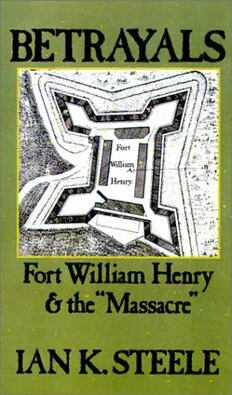
Betrayals: Fort William Henry and the "Massacre" PDF
Preview Betrayals: Fort William Henry and the "Massacre"
BETRAYALS BY THE SAME AUTHOR Politics of Colonial Policy Guerillas and Grenadiers Atlantic Merchant-apothecary The English Atlantic 1675-1740 BETRAYALS Fort William Henry and the "Massacre" IAN K. STEELE New York Oxford OXFORD UNIVERSITY PRESS 1990 Oxford University Press Oxford New York Toronto Delhi Bombay Calcutta Madras Karachi Petaling Jaya Singapore Hong Kong Tokyo Nairobi Dar es Salaam Cape Town Melbourne Auckland and associated companies in Berlin Ibadan Copyright © 1990 by Ian K. Steele Published by Oxford University Press, Inc., 200 Madison Avenue, New York, New York 10016 Oxford is a registered trademark of Oxford University Press All rights reserved. No part of this publication may be reproduced, stored in a retrieval system, or transmitted, in any form or by any means, electronic, mechanical, photocopying, recording, or otherwise, without the prior permission of Oxford University Press. Library of Congress Cataloging-in-Publication Data Steele, Ian Kenneth. Betrayals : Fort William Henry and the "massacre" / Ian K. Steele. p. cm. Includes bibliographical refrences. ISBN 0-19-505893-3 1. Fort William Henry (N.Y.)—Capture, 1757. 2. Massacres—New York (State)—Fort William Henry—History—18th century. I. Title. E199.S82 1990 973.2'6—dc20 89-16266 1 3 5 7 9 8 6 4 2 Printed in the United States of America on acid-free paper To the Memory of GERALD S. GRAHAM JOSEPH J. MALONE GEORGE METCALF This page intentionally left blank PREFACE The compelling events of the brief existence of Fort William Henry, explored while studying the treatment of prisoners of war, have simply demanded a careful retelling. The well-documented realities were much more subtle and revealing than James Fenimore Cooper's myth- ical classic The Last of the Mohicans (1826). The mixture of Indian, colonial, and European values produced cooperation, conflict, and confusion within the armies that fought for the Albany-Montreal corridor. The Battle of Lake George demonstrates the confusion ac- companying the unprecedented commitment of European military re- sources to the persistent colonial rivalries on this frontier. The fort itself was an assertion of the European military presence on builders, garrisons, and enemies in this wilderness. The seige of 1757 displayed the uneasy, but effective, combination of Indian, colonial, and Euro- pean warfare. The climactic "massacre at Fort William Henry" was a foreseeable collision of attitudes about prisoners of war, rather than the drunken or "homicidal" rage that has been depressingly popular as an explanation among historians. The remembering of Fort William Henry has served a variety of purposes over the centuries. The conflict between European and colo- nial values and methods has been a favorite theme of historians seeking the roots of American and Canadian identity. The "massacre," which left more killed and missing than those at Deerfield or Lachine, became powerful in American folk memory, confirming attitudes to- ward American Indians that justified "removals" and wars. From this distance, the short and tragic story seems to have been part of the nineteenth century's "usable past." The twentieth century has, perhaps with humane intention, tended to forget Fort William Henry, or leave it to the "literature" of James Fenimore Cooper, Francis Parkman, or H.-R. Casgrain. What follows is a retelling based on new as well as familiar sources, an analysis of casualties and consequences, and an essay on the witnesses and the historians. This reopening of a sensitive viii / PREFACE subject is offered with the hope that readers will agree that under- standing is preferable to forgetting. Naming the people and places, like the rest of this faceted story, is not simple or value free. I have labeled the opposing armies "English" and "French," as their opponents did in recognition of their kings or the dominant languages in each. While the English empire was becom- ing more British at this time, the term "British" here refers to natives of Britain. "Americans" was in use for English colonists, though in the military the term "provincials" was more common. The Chippewa are here called the "Ojibwa," and the Iroquois in Canada are usually named the "Caughnawaga," after their major settlement, to distin- guish them from their kin farther south. The struggle on the frontier between New York and Montreal was also a war of place names. Albany (L'Orange), Fort Edward (Lydius), Fort William Henry (Fort Georges), Fort Carillon (Ticonderoga), and Fort St. Frederic (Crown Point) are given the names assigned by their possessors during this story. The disputed Lac St. Sacrement might well have borne that name here, but the serenity of the "holy lake" was gone after the autumn of 1755, when William Johnson pretentiously claimed it, renamed it, and fought a battle that has been called the Battle of Lake George ever since. Special thanks are due to a number of people who assisted with aspects of this book. The University of Western Ontario helped with re- search time and resources. Archivists who helped beyond legitimate expectations include Galen Wilson of the William L. Clements Library; Martha Briggs of the Huntington Library; State Archivist Frank C. Mevers of New Hampshire; Voorhees Dunn of the State of New Jersey Division of Archives and Records Management; Pat Robinson and Michel Wyczynski of the National Archives of Canada; and Jane M. Lape of Fort Ticonderoga. My colleagues Professors F. A. Dreyer, R. L. Emerson, and G. N. Emery have offered valuable criticism of parts of this study. Herta Steele, who has given the author's life much of its meaning, has given even more than her customary interest and effort to the research and thorough copy editing of the entire manuscript. Surviving errors remain the exclusive property of the author. London, Ontario I.K.S. June 1989 CONTENTS PAGE 1. Approaches 3 2. To Battle for Lake George 28 3. Fort William Henry, 1755-1757 57 4. Siege 78 5. "Massacre" 109 6. Aftermath 129 7. Perceptions 149 APPENDIX: Missing New England Parolees 187 Notes 200 Index 241
